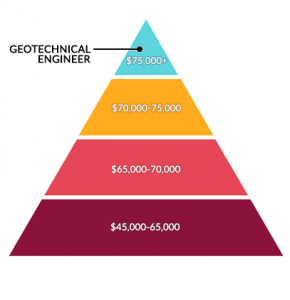The 4-Minute Rule for Geotheta
The 4-Minute Rule for Geotheta
Blog Article
Indicators on Geotheta You Should Know
Table of ContentsThe Single Strategy To Use For GeothetaUnknown Facts About GeothetaThe 8-Minute Rule for GeothetaFascination About GeothetaThe Buzz on Geotheta

They conduct site investigations, gather examples, carry out research laboratory examinations, and evaluate data to examine the viability of the ground for building and construction tasks - Tailings Engineer. Based upon their findings, geotechnical designers give referrals for foundation style, incline security, keeping structures, and mitigation of geotechnical hazards. They team up with various other experts, such as architects, architectural designers, and building and construction groups, to make sure that geotechnical factors to consider are incorporated into the overall project layout and execution
By examining the behavior and homes of dirt and rock, they can determine potential geotechnical threats such as landslides, dirt negotiation, or incline instability. Their know-how helps avoid failings or crashes that could threaten lives and home. Below are some detailed obligations and responsibilities of a geotechnical engineer: Site Examination: Geotechnical designers conduct site investigations to collect data on subsurface conditions.
They translate the data to recognize the homes and behavior of the soil and rock, including their strength, leaks in the structure, compaction features, and groundwater problems. Geotechnical Analysis and Design: Geotechnical engineers examine the information gathered during site investigations to evaluate the security and suitability of the website for building and construction tasks. They execute geotechnical estimations and modeling to review elements such as birthing ability, settlement, slope security, lateral earth stress, and groundwater flow.
Not known Details About Geotheta
Foundation Design: Geotechnical designers play an important duty in designing structures that can safely support the designated framework. They evaluate the dirt problems and load demands to determine the suitable foundation type, such as superficial foundations (e.g., footings), deep foundations (e.g (https://geotheta-46958753.hubspotpagebuilder.com/blog/unlocking-the-future-with-top-notch-geotechnical-engineers-at-geotheta)., heaps), or specialized techniques like dirt renovation. They take into consideration elements such as negotiation limits, birthing ability, and soil-structure interaction to develop optimal foundation styles
They assess construction plans, monitor site activities, and conduct area evaluations to verify that the design suggestions are adhered to. If unforeseen geotechnical concerns emerge, they analyze the circumstance and offer suggestions for removal or changes to the style. Risk Assessment and Mitigation: Geotechnical engineers assess geotechnical risks and dangers connected with the job website, such as landslides, liquefaction, or soil erosion.

Partnership and Communication: Geotechnical engineers function very closely with other professionals included in a job, such as designers, structural engineers, and construction teams. Reliable communication and partnership are vital to integrate geotechnical considerations into the overall task style and construction procedure. Geotechnical engineers provide technological expertise, response questions, and ensure that geotechnical needs are fulfilled.
Geotheta Can Be Fun For Everyone
Right here are some kinds of geotechnical designers: Foundation Engineer: Structure engineers specialize in making and assessing structures for structures. They examine the dirt problems, load needs, and site qualities to figure out the most ideal foundation kind and design, such as superficial foundations, deep structures, or specialized techniques like pile structures.
They examine the variables affecting incline security, such as soil homes, groundwater conditions, and incline geometry, and create approaches to avoid slope failures and alleviate threats. Quake Designer: Quake designers concentrate on assessing and developing structures to stand up to seismic forces. They assess the seismic threat of a website, assess dirt liquefaction capacity, and establish seismic layout criteria to make certain the safety and security and durability of frameworks during earthquakes.
They carry out area screening, collect examples, and evaluate the accumulated information to identify the dirt residential or commercial properties, geologic formations, and groundwater problems at a site. Geotechnical Instrumentation Engineer: Geotechnical instrumentation designers concentrate on tracking and gauging the behavior of dirt, rock, and frameworks. They set up and preserve instrumentation systems that keep an eye on elements such as soil negotiation, groundwater levels, incline motions, and structural displacements to assess performance and offer very early cautions of potential problems.
Geotheta Fundamentals Explained
They conduct examinations such as triaxial examinations, combination examinations, straight shear tests, and leaks in the structure tests to gather data for geotechnical analysis and style. Geosynthetics Designer: Geosynthetics engineers concentrate on the design and application of geosynthetic materials, such as geotextiles, geogrids, and geomembranes. They utilize these products to boost soil stability, enhance slopes, provide drainage solutions, and control disintegration.
They have a tendency to be investigatory people, which implies they're intellectual, introspective, and analytical. They wonder, systematic, sensible, logical, and sensible. A few of them are likewise social, indicating they're kind, generous, participating, client, caring, handy, compassionate, sensible, and pleasant. Does this seem like you? Take our free profession examination to discover out if geotechnical designer is among your leading occupation suits.
In the workplace environment, geotechnical designers use specialized software tools to carry out calculations, produce layouts, and evaluate information. They prepare reports, review task specs, communicate with customers and staff member, and coordinate project activities. The workplace setting offers a favorable setting for research study, analysis, and partnership with various other professionals associated with the job.
Some Known Facts About Geotheta.
They regularly check out task websites to conduct website investigations, examine geotechnical problems, and gather information for evaluation. These their website sees include taking a trip to different places, in some cases in remote or tough terrains. Geotechnical designers might perform soil sampling, conduct tests, and display building activities to make sure that the geotechnical facets of the job are being applied properly.
Geotechnical designers likewise function in specialized geotechnical labs. In these centers, they carry out experiments, execute tests on dirt and rock samples, and assess the engineering residential or commercial properties of the materials. Geotechnical lab designers function extensively in these settings, managing screening devices, running tools, and taping information. They work together with various other research laboratory staff to make certain exact and trusted testing outcomes.
Report this page